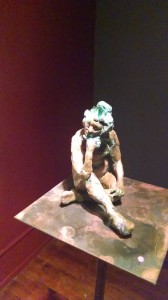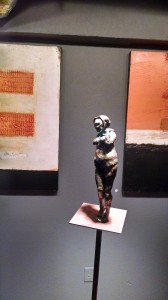Last night, I played the role of proud papa as I attended my daughter’s first art talk at the Pomona Framehouse/
Main Street Gallery. Toiling alongside her mentor, Bill Catling, a sculptor in his own right, my daughter, Carolyn Allbaugh, worked for six months to create ten bronze figures for this show. Some were based on women she knew, and some were not.
As the proud father (I recorded her talk and everything that was said during her talk about her work and herself), I will admit that my wife and I passed the word around about our Carolyn’s show at our work and in our church. I should add that the response was overwhelmingly positive and congratulatory. Though one person looking at her announcement said, “Oh, they’re nudes,” as though this put her work in a bad light, most people we shared this with didn’t seem to notice this and were instead impressed with her work. I got over it and focused mostly on the encouragement coming from people we know.
I’ve long been used to the idea that the church has a tenuous relationship with art and a narrow bandwidth on what will be deemed “acceptable.” A platonic dislike for art, the material, and the body seems to run as a mostly unconscious stream through most church aesthetics, so it is not surprising that sincere representations of the human body will be deemed “controversial.” At the same time—and this is surprisingly contrary to Plato—big emotion, even emotional manipulation, will often find a home in the hearts of church-goers everywhere.
The talk my daughter gave last night, however, addressed some of this. Being mostly outside of the field, I don’t get to hear conversations about sculpture and painting every day. Since what we hear and do everyday tends to feel like it is normal, I feel a need to pass on some of what I heard.
Nudes the Way Artists See Them
First, as my daughter noted, the depiction of nudity in her figures was not sexual but an attempt to express something important about how women feel about themselves. Indeed, I was privileged to observe how strongly the women in attendance responded to the emotional quality of her work, some claiming that they recognized themselves in the figures.
George Cuttress, the owner and curator of the Main Street Gallery, underscored this when he stated that he and his wife have long valued nude figures done by women. “In these times of commercialism of the human body,” he notes in his Gallery Statement for Carolyn, “from advertising in all forms of media, we are brainwashed into accepting what’s in reality abnormal as to how we all should look. It is so refreshing to put things in a more balanced perspective and view ourselves through the eyes of the ‘woman’ as artist.”
I was so gratified that someone of Cuttress’s stature would acknowledge Carolyn’s ideas and expression. And her figures were very expressive, “refreshing” in this regard, as one sculptor in attendance said. And that was another interesting point to reflect on as the night drew to a close.
Mentors and Meaning
Professor Bill Catling, MFA, Carolyn’s mentor, noted that there is currently a turning away from the cheap and meaningless in the art world and a greater interest in what is meaningful. As a Christian, Catling quoted Carl Jung to the effect that “meaninglessness is a disease.”
Having been exposed to mostly Modernist manifestos when I was studying and then Postmodern ideas of meaning in texts as mere “traces,” I found this startling. My daughter’s figures, termed “abstract” by George Cuttress, but also “expressive,” would seem to capture something of what some may be moving toward with their art.
I am reminded, of course, that meaningful art does not mean conventional. There is a tendency to equate the two and to accept only those forms that we recognize as meaningful, mainly due to their being conventional. But I suspect this isn’t entirely the case. If it were, then we’d all be writing romances and murder mysteries and painting landscapes again—traditional landscapes, the sort of art that Hitler endorsed as worthy of the 3rd Reich after his rise to power.


Congratulations on having a gifted woman artist for a daughter! I’m following your blog just fine until the last sentence that seems to link traditional landscape art with Hitler. William Constable (1776-1837) comes to mind as a traditional British Romantic landscape painter, but surely his kind of art is not what you mean . Or is it? What am I missing?
Thanks, Emily, for your comments and for your question about the last line. I tend to hurry in writing these blogs. I too love John Constable (I think he was named John) and have a print of one of his works in my office at school. I had a prof who pretty much argued that there was a link connecting Constable to the later French impressionists. What I’m suggesting in the last line comes from reading a memoir by Albert Speer, Hitler’s architect, who had some things to say about Hitler’s narrow taste in art–that he would only sanction the most literal and representational in art. I had this sense that Constable was already moving in an impressionistic direction. Anyway, I hope this clarifies things. I think I am responding to the need to stay only with a narrow, mostly conventional idea of what can be done.
Sorry. Albert Speer was a young architect who became Hitler’s Weapons Minister, or some title like that.
Your daughter exhibited nudes in the tradition of Bill Catling’s of full humanity, fallen angels, missing parts, loneliness, absence of the opposite, sexual vulnerability, nakedness. “How did you know you are naked?”, asked the Lord. “Because of the woman…”, replied Man, or rather he should have said: because of the absence from the Woman, because I am no longer united to her, part of her, with her, then I can see I am naked, vulnerable. The naked bronzes of Catling first caught my attention because they reminded me of the Venezuelan sculptures of Cornelis Zitman, but no, the comparisson is not valid. Zitman’s are anything but vulnerable. They are totally naked, and yet they are fully clothed.
Thanks, Maria, for the reminder. “Vulnerability” is one of the words Carolyn used last night to describe her work. This is very much in keeping with Bill Catling’s work, and it is very different from most work with nudity, which, as my daughter has said, is expressed out of an attempt to draw attention to one’s self.
Wow! Sounds awesome! sorry I missed that. Tell Carolyn congratulations!
I’m so disappointed that we couldn’t get to the gallery during her show! That sounds like a fantastic artist’s talk.
I’m not sure what it says about me that I didn’t even think about the image on her flyer being “a nude.” I thought, “Oh, impressive sculpture of a woman.” Perhaps that just speaks to the quality of her art.
Katie, I had a similar reaction. I wasn’t thinking nude but responding to the emotion in the figure’s expression.
Two striking points: The church is uncomfortable with the human body and yet all too comfortable with big emotion, “even emotional manipulation.”
And
The value of seeing the human body through the eyes of a woman.
Such profound reflections! I’m chewing on these. Thanks for the food for thought.
I want to see Carolyn’s work! For those of us who are states away, can we go on-line anywhere to see her work?
Christin, thanks for your interest in Carolyn’s work. I have pictures of a few of her pieces on my Facebook page, but she tells me that she is working right now to post pictures online. She tells me that when she is finished, she will let me link it to this site. I will let you know.
Congratulations to Carolyn for this show, and to you and Bernadette for raising an artist! I appreciate your comments on art and also look forward to seeing more photos of Carolyn’s work.